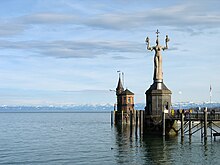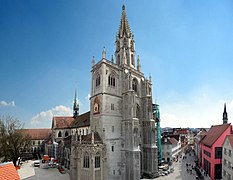Konstanz
Constance
Konstanz | |
|---|---|
 Rheintorturm, a section of the former city wall of Konstanz at Lake Constance | |
Location of Constance within Konstanz district  | |
| Coordinates: 47°40′N 9°11′E / 47.667°N 9.183°E | |
| Country | Germany |
| State | Baden-Württemberg |
| Admin. region | Freiburg |
| District | Konstanz |
| Subdivisions | 15 |
| Government | |
| • Lord mayor (2020–28) | Ulrich Burchardt[1] (CDU) |
| Area | |
| • Total | 55.65 km2 (21.49 sq mi) |
| Elevation | 405 m (1,329 ft) |
| Population (2022-12-31)[2] | |
| • Total | 85,859 |
| • Density | 1,500/km2 (4,000/sq mi) |
| Time zone | UTC+01:00 (CET) |
| • Summer (DST) | UTC+02:00 (CEST) |
| Postal codes | 78462–78467 |
| Dialling codes | 07531, 07533 |
| Vehicle registration | KN |
| Website | www.konstanz.de |
Konstanz (
Location

The city is located in the state of Baden-Württemberg and situated at the banks of Lake Constance (Bodensee in German). The river Rhine, which starts in the Swiss Alps, passes through Lake Constance and leaves it, considerably larger, by flowing under a bridge connecting the two parts of the city. North of the river lies the larger part of the city with residential areas, industrial estates, and the University of Konstanz; while south of the river is the old town, which houses the administrative centre and shopping facilities in addition to the Hochschule or the University of Applied Sciences. Car ferries provide access across Lake Constance to Meersburg, and the Katamaran provides a shuttle service for pedestrians to Friedrichshafen. The Germany–Switzerland border runs along the southwestern and southern edge of the city, demarcating it from the Swiss town of Kreuzlingen.
Subdivisions
Konstanz is subdivided into 15 wards or districts (Stadtteile). The island of Mainau belonged to the ward of Litzelstetten, a separate municipality, until its incorporation into Konstanz on 1 December 1971.

History
The first traces of civilization in Konstanz date back to the late Stone Age. During the reign of
Around 585 the first bishop took up residence in Konstanz and this marked the beginning of the city's importance as a spiritual center. By the late Middle Ages, about one quarter of Konstanz's 6,000 inhabitants were exempt from taxation on account of clerical rights.
Trade thrived during the Middle Ages. Konstanz owned the only bridge in the region, which crossed the Rhine, making it a strategic location in the
In 1414 to 1418, the
In 1460, the Swiss Confederacy conquered Thurgau, Konstanz's natural hinterland. Konstanz then made an attempt to get admitted to the Swiss Confederacy, but the forest cantons voted against its entry, fearing overbearing city states; Konstanz then joined the Swabian League instead. In the Swabian War of 1499, Konstanz lost its last privileges over Thurgau to the Confederation.
The
The city became part of the
On 22 October 1940, 110 of the last Jewish residents were deported to
Because it almost lies within Switzerland, directly adjacent to the Swiss border, Konstanz was not bombed by the Allied Forces during World War II. After the war, Konstanz was included first in South Baden and then in the new state of Baden-Württemberg.
The Altstadt (Old Town), which is large considering the small size of modern Konstanz, has many old buildings and twisting alleys. The city skyline is dominated by
The
Konstanz was the birthplace of Count Ferdinand von Zeppelin, constructor of the famous Zeppelin airships. In the late 2010s, Konstanz has become a popular destination for Einkaufstourismus, or
| Largest groups of foreign residents | |
| Nationality | Population (2014) |
| 1,627 | |
| 1,132 | |
| 568 | |
| 565 | |
| 500 | |
| 381 | |
Climate
Its location in south-west Germany gives Konstanz a degraded oceanic climate (Köppen: Cfb) with warm and humid summers (moderated by the lake) as well as cold and snowy winters.
| Climate data for Konstanz (1991–2020 normals, extremes 1961–2021) | |||||||||||||
|---|---|---|---|---|---|---|---|---|---|---|---|---|---|
| Month | Jan | Feb | Mar | Apr | May | Jun | Jul | Aug | Sep | Oct | Nov | Dec | Year |
| Record high °C (°F) | 16.3 (61.3) |
19.4 (66.9) |
24.4 (75.9) |
30.7 (87.3) |
33.1 (91.6) |
36.3 (97.3) |
36.9 (98.4) |
36.5 (97.7) |
30.9 (87.6) |
27.5 (81.5) |
22.0 (71.6) |
17.0 (62.6) |
36.9 (98.4) |
| Mean daily maximum °C (°F) | 3.9 (39.0) |
5.8 (42.4) |
11.1 (52.0) |
16.0 (60.8) |
20.3 (68.5) |
23.9 (75.0) |
25.7 (78.3) |
25.3 (77.5) |
20.3 (68.5) |
14.6 (58.3) |
8.2 (46.8) |
4.5 (40.1) |
15 (59) |
| Daily mean °C (°F) | 1.2 (34.2) |
2.1 (35.8) |
6.0 (42.8) |
10.2 (50.4) |
14.5 (58.1) |
18.1 (64.6) |
19.9 (67.8) |
19.5 (67.1) |
15.0 (59.0) |
10.3 (50.5) |
5.2 (41.4) |
2.0 (35.6) |
10.3 (50.5) |
| Mean daily minimum °C (°F) | −1.0 (30.2) |
−0.9 (30.4) |
2.0 (35.6) |
5.2 (41.4) |
9.5 (49.1) |
13.2 (55.8) |
15.0 (59.0) |
14.8 (58.6) |
11.1 (52.0) |
7.3 (45.1) |
2.9 (37.2) |
−0.1 (31.8) |
6.6 (43.9) |
| Record low °C (°F) | −21.8 (−7.2) |
−21.5 (−6.7) |
−17.5 (0.5) |
−6.2 (20.8) |
−4.4 (24.1) |
0.2 (32.4) |
3.7 (38.7) |
4.0 (39.2) |
−0.5 (31.1) |
−4.0 (24.8) |
−9.5 (14.9) |
−14.0 (6.8) |
−21.8 (−7.2) |
| Average precipitation mm (inches) | 45.8 (1.80) |
44.8 (1.76) |
50.6 (1.99) |
56.5 (2.22) |
89.2 (3.51) |
99.7 (3.93) |
96.3 (3.79) |
97.7 (3.85) |
69.4 (2.73) |
62.8 (2.47) |
57.5 (2.26) |
63.2 (2.49) |
833.7 (32.82) |
| Average precipitation days (≥ 1.0 mm) | 14.1 | 12.8 | 14.1 | 13.1 | 15.0 | 15.5 | 15.2 | 14.8 | 13.3 | 14.0 | 14.2 | 15.8 | 171.9 |
| Average snowy days (≥ 1.0 cm) | 7.0 | 7.2 | 2.1 | 0.2 | 0 | 0 | 0 | 0 | 0 | 0.1 | 1.7 | 5.3 | 23.6 |
| Average relative humidity (%)
|
85.9 | 80.8 | 73.8 | 68.8 | 70.3 | 70.2 | 70.1 | 73.5 | 79.7 | 85.5 | 87.6 | 87.6 | 77.8 |
| Mean monthly sunshine hours | 49.1 | 75.4 | 129.8 | 205.2 | 239.7 | 239.6 | 234.2 | 214.4 | 161.5 | 116.0 | 52.0 | 37.7 | 1,824.1 |
| Source 1: ) | |||||||||||||
| Source 2: Data derived from Deutscher Wetterdienst[10] | |||||||||||||
| Climate data for Konstanz, 2015-2020 normals | |||||||||||||
|---|---|---|---|---|---|---|---|---|---|---|---|---|---|
| Month | Jan | Feb | Mar | Apr | May | Jun | Jul | Aug | Sep | Oct | Nov | Dec | Year |
| Mean daily maximum °C (°F) | 4.3 (39.7) |
5.8 (42.4) |
11.8 (53.2) |
16.7 (62.1) |
20.1 (68.2) |
25.5 (77.9) |
27.5 (81.5) |
26.7 (80.1) |
21.3 (70.3) |
15.4 (59.7) |
9.1 (48.4) |
5.4 (41.7) |
15.8 (60.4) |
| Mean daily minimum °C (°F) | −0.1 (31.8) |
0.0 (32.0) |
2.7 (36.9) |
6.0 (42.8) |
10.0 (50.0) |
14.7 (58.5) |
16.5 (61.7) |
16.0 (60.8) |
11.9 (53.4) |
8.0 (46.4) |
4.2 (39.6) |
1.2 (34.2) |
7.6 (45.7) |
| Average precipitation mm (inches) | 57.2 (2.25) |
37.5 (1.48) |
38.3 (1.51) |
60.6 (2.39) |
99.2 (3.91) |
85.1 (3.35) |
74.1 (2.92) |
89.1 (3.51) |
44.2 (1.74) |
52.2 (2.06) |
47.1 (1.85) |
30.4 (1.20) |
714.9 (28.15) |
| Average precipitation days (≥ 1.0 mm) | 9.5 | 8.5 | 10.7 | 10.4 | 11.3 | 11.9 | 11.5 | 10.8 | 9.5 | 9.1 | 9.7 | 10.7 | 123.6 |
| Average relative humidity (%)
|
84 | 80 | 75 | 72 | 73 | 74 | 74 | 77 | 81 | 85 | 86 | 85 | 79 |
| Mean monthly sunshine hours | 54 | 83 | 157 | 207 | 208 | 252 | 280 | 246 | 189 | 121 | 60 | 53 | 1,910 |
| Source 1: DWD[11] and MeteoSchweiz (unavailable) | |||||||||||||
| Source 2: weather-online[12] | |||||||||||||
| Climate data for Konstanz (Mainau Forest), elevation: 447 m, 1961-1990 normals and extremes | |||||||||||||
|---|---|---|---|---|---|---|---|---|---|---|---|---|---|
| Month | Jan | Feb | Mar | Apr | May | Jun | Jul | Aug | Sep | Oct | Nov | Dec | Year |
| Record high °C (°F) | 14.2 (57.6) |
17.4 (63.3) |
24.4 (75.9) |
28.0 (82.4) |
33.1 (91.6) |
33.7 (92.7) |
36.0 (96.8) |
33.5 (92.3) |
30.5 (86.9) |
27.5 (81.5) |
22.0 (71.6) |
17.0 (62.6) |
36.0 (96.8) |
| Mean daily maximum °C (°F) | 2.4 (36.3) |
4.6 (40.3) |
9.5 (49.1) |
14.0 (57.2) |
18.6 (65.5) |
21.8 (71.2) |
24.1 (75.4) |
23.3 (73.9) |
20.1 (68.2) |
13.8 (56.8) |
7.2 (45.0) |
3.3 (37.9) |
13.6 (56.4) |
| Daily mean °C (°F) | 0.0 (32.0) |
1.3 (34.3) |
4.7 (40.5) |
8.7 (47.7) |
13.1 (55.6) |
16.3 (61.3) |
18.5 (65.3) |
17.7 (63.9) |
14.7 (58.5) |
9.7 (49.5) |
4.3 (39.7) |
1.0 (33.8) |
9.2 (48.5) |
| Mean daily minimum °C (°F) | −2.2 (28.0) |
−1.4 (29.5) |
1.1 (34.0) |
4.2 (39.6) |
8.2 (46.8) |
11.6 (52.9) |
13.6 (56.5) |
13.4 (56.1) |
10.7 (51.3) |
6.8 (44.2) |
2.0 (35.6) |
−1.0 (30.2) |
5.6 (42.1) |
| Record low °C (°F) | −21.8 (−7.2) |
−21.5 (−6.7) |
−17.5 (0.5) |
−6.2 (20.8) |
−4.4 (24.1) |
0.2 (32.4) |
3.7 (38.7) |
4.0 (39.2) |
−0.5 (31.1) |
−4.0 (24.8) |
−9.5 (14.9) |
−14.0 (6.8) |
−21.8 (−7.2) |
| Average precipitation mm (inches) | 52.0 (2.05) |
51.0 (2.01) |
51.0 (2.01) |
68.0 (2.68) |
85.0 (3.35) |
105.0 (4.13) |
102.0 (4.02) |
88.0 (3.46) |
71.0 (2.80) |
54.0 (2.13) |
65.0 (2.56) |
57.0 (2.24) |
849 (33.44) |
| Average precipitation days (≥ 1.0 mm) | 10.0 | 9.0 | 10.0 | 11.0 | 13.0 | 12.0 | 12.0 | 12.0 | 8.0 | 8.0 | 10.0 | 10.0 | 125 |
| Mean monthly sunshine hours | 43.0 | 73.4 | 124.9 | 161.7 | 198.6 | 218.1 | 244.6 | 215.3 | 171.1 | 99.8 | 52.6 | 37.0 | 1,640.1 |
| Source: NOAA[9] | |||||||||||||
Main sights
- Archaeological Museum
- Imperia, a 9 m-tall sculpture
- Jan Hus Museum
- Konstanz Cathedral
- Konzil edifice, dating to the 15th century
- Niederburg (Lower Castle)
- Petershausen Abbey
- Remains of a Roman fortress, near the Cathedral
- Schnetztor, fortified gate of the former city walls
Konstanz was also home to a large
Twin towns – sister cities
 Fontainebleau, France (1960)
Fontainebleau, France (1960) Richmond upon Thames, England, United Kingdom (1983)
Richmond upon Thames, England, United Kingdom (1983) Tábor, Czech Republic (1984)
Tábor, Czech Republic (1984) Lodi, Italy (1986)
Lodi, Italy (1986) Suzhou, China (2007)
Suzhou, China (2007)
Transport
Additionally Konstanz and Friedrichshafen have been connected by the two (since 2008, three) catamarans Constance and Fridolin since 2005.
World Heritage Site
It is home to one or more prehistoric
Notable people
Public service and commerce


- Ulrich Zasius (1461–1536), jurist [15]
- Ernst Vögelin (1529–1589), pioneer book printer
- Wacker von Wackenfels (1550–1619), diplomat, scholar and author
- Johann Friedrich Cotta (1764–1832) a publisher, industrial pioneer and politician; in 1825 he started steamboats on Lake Constance.[16]
- Johann Leonhard Hug (1765–1846) a Catholic theologian, orientalist and biblical scholar.[17]
- Guillaume Henri Dufour (1787–1875) a Swiss military officer, structural engineer and topographer.[18]
- Count Ferdinand von Zeppelin (1838–1917), a German general and inventor of the Zeppelin rigid airships.[19]
- Josef Albert Amann (junior) (1866–1919), gynecologist
- Conrad Grober(1872–1948), priest and archbishop, teacher and pastor in Konstanz
- Friedrich Flick (1883–1972), entrepreneur and convicted Nazi war criminal
- Michaela von Neipperg (1885–1957), countess and Benedictine nun, religious superior at the Municipal Women's Clinic Konstanz
- Siegfried Adolf Handloser (1885–1954), doctor of the German Armed Forces Medical Services
- Melanie Risch (1887–1944), victim of Nazism
- Werner Berger (1901–1964), SS-Oberscharführer and member of commando 99 in Buchenwald concentration camp
- Julius Federer (1911–1984), jurist
- Egon Mayer (1917–1944), fighter ace in the Luftwaffe during World War II
- Werner Maihofer (1918–2009), politician (FDP), member of Bundestag, minister of the interior (1974–1978)
- Theo Sommer (1930–2022), newspaper editor at Die Zeit since 1958, rising to editor-in-chief and publisher
- Rolf Böhme (1934–2019), Staatssekretär (1978–1982), mayor of Freiburg (1982–2002)
- Horst Frank (b. 1949), jurist, Lord Mayor of Konstanz 1996–2012
- Ian Murdock (1973–2015), American software engineer, founder of the Debian project
- Larissa Vassilian (born 1976), German-Armenian journalist

The arts
- Tobias Pock (1609–1683), Austrian Baroque painter of Swabian descent, a pioneer of sacral art
- Marie Ellenrieder (1791–1863), painter
- Jacob Picard (1883–1967), writer
- Anne Winterer (1894–1938), photographer
- François Stahly (1911–2006), French sculptor
- Hans Maria Wingler (1920–1984), art historian and founder of Bauhaus-Archive
- Rosemarie Banholzer (born 1925), dialect author
- Berthold Keller (1927–2012), trade unionist
- Martin Gotthard Schneider (1930–2017), church musician, songwriter and theologian
- Uli Trepte (1941–2009), musician
- Carola Zwick (born 1966), product designer
Gallery
-
The late Roman fortress Constantia at the Münsterplatz
-
The Konzilgebäude in Konstanz
-
Konstanz Marktstätte, the main square in the old town
See also
- Alexander-von-Humboldt-Gymnasium
- Cathedral of Konstanz
- Hochschule Konstanz(University of Applied Sciences)
- University of Konstanz
- Tägermoos
Notes
References
- ^ Aktuelle Wahlergebnisse, Staatsanzeiger, accessed 13 September 2021.
- Statistisches Landesamt Baden-Württemberg. June 2023.
- ISBN 978-1-4058-8118-0.
- ^ "Konstanz". The American Heritage Dictionary of the English Language (5th ed.). HarperCollins. Retrieved 21 July 2019.
- ^ "Konstanz". Collins English Dictionary. HarperCollins. Retrieved 21 July 2019.
- ^ "Constance". Merriam-Webster.com Dictionary. Retrieved 21 July 2019.
- Slate. Retrieved March 6, 2017.
- ^ "World Meteorological Organization Climate Normals for 1991–2020: Konstanz". World Meteorological Organization Climatological Standard Normals (1991–2020). National Oceanic and Atmospheric Administration. Archived from the original on 12 October 2023. Retrieved 12 October 2023.
- ^ a b "Konstanz (10929) - WMO Weather Station". NOAA. Retrieved February 5, 2019.
- ^ "Wetter und Klima - Deutscher Wetterdienst - CDC (Climate Data Center)". www.dwd.de.
- ^ "Ausgabe der Klimadaten: Monatswerte".
- ^ "Kostanz (442m)". weatheronline.co.nz.
- ^ "Städtepartnerschaften". konstanz.de (in German). Konstanz. Retrieved 2021-02-16.
- ^ Centre, UNESCO World Heritage. "Prehistoric Pile Dwellings around the Alps". whc.unesco.org.
- ^ . Catholic Encyclopedia. Vol. 15. 1912.
- ^ . Encyclopædia Britannica. Vol. 7 (11th ed.). 1911. pp. 250–251, page 251.
his youngest son, Johann Friedrich, Freiherr Cotta von Cottendorf (1764–1832).... In 1825 he started steamboats, for the first time, on Lake Constance, and introduced them in the following year on the Rhine.
- ^ . Encyclopædia Britannica. Vol. 13 (11th ed.). 1911. p. 856.
- ^ . Encyclopædia Britannica. Vol. 8 (11th ed.). 1911. p. 646.
- ^ . Encyclopædia Britannica. Vol. 32 (12th ed.). 1922. p. 1128.
External links
- Coolidge, William Augustus Brevoort (1911). . Encyclopædia Britannica. Vol. 6 (11th ed.). pp. 984–985.
- Official website
- (in German) Konstanz: history and images at "alemannische-seiten.de"
- University of Konstanz
- Pictures Konstanz
- Online journal about Constance
- University of Applied Sciences
- Photos of the Carnival (~Shrovetide, ~Mardi Grass) in Constance
- Südkurier (Südkurier) Local newspaper for Konstanz









